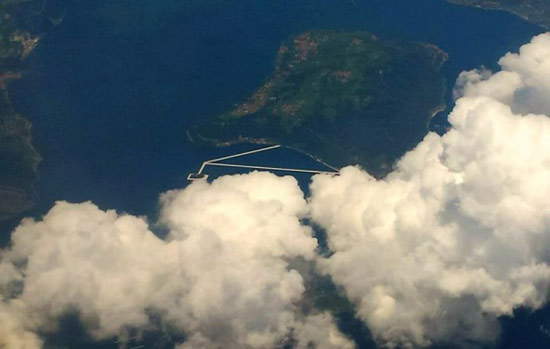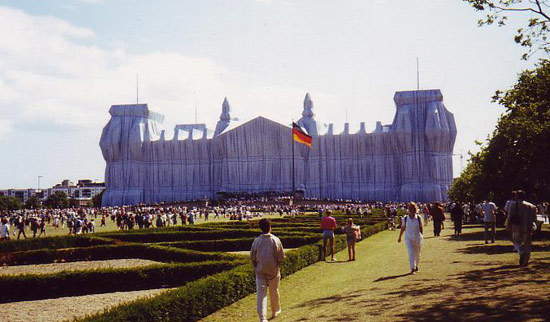As is well known, so much criticism has rained down on The Floating Piers, Christo and Jeanne-Claude ’s work on Lake Iseo, in recent days. The problem is that very little has been said about the art, and so much about the side dish. For example: when Philippe Daverio, a person for whom we hold great esteem, says that the work is"an alternative to village festivals," he is not expressing a criticism of the work: it is not the artist’s job to make sure that his installation is not mistaken for a fairground ride. If it has been trivially reduced to such a function, it is because institutions and the media have been creating, for months, a huge expectation for The Floating Piers by granting it a media prominence that has rarely, at least going by memory, been granted for awork of contemporary art. The village festival, in essence, is not the work, but is around the work. And entirely specious appears to be Vittorio Sgarbi’s criticism that the work has"nothing to do with the enhancement of the land." Sgarbi perhaps forgets that Christo is an artist, not an alderman.
 |
| Christo and Jeanne-Claude, The Floating Piers (2016) from above. Photo by Luca Zuccala of ArtsLife. |
More interesting is an article by Pierluigi Panza that came out a few days ago on his blog Fatto ad Arte (Corriere della Sera), in which there is a link to a further piece published on the blog of a writer, Giulia Inverardi, who lives on Lake Iseo and expresses all her more than legitimate doubts about the operation. Among the accusations levelled against Christo is that the artist is not much inclined to dialogue with local communities in the realization of the works, and as a result his installations would lack democratic character, appearing almost as decisions cast from above. These criticisms are interesting not so much in that they are well-founded: Christo always goes about asking for the appropriate permissions for his artworks, and his statements, which often appear contradictory and sometimes deliberately provocative (and in this way of relating to the media, Christo shows an attitude quite similar to that of Andy Warhol, whose contradictions almost constituted a stylistic signature), should always be handled with due caution. If, for example, in an interview granted to Abitare magazine, Christo declared that his contacts with the local community are limited to requesting authorizations (while stating that when the artist installs a work he “borrows a public space” thus inheriting “all the elements that make up the reality of this place” and inevitably ending up “involving the people who live this space daily, physically”), in another interview, given to Corriere, the artist stated that he “always has the support of the communities we work with.” otherwise, Christo “gives up the project.” If it is therefore already difficult to interpret all of Christo’s statements, even those that are openly at odds with each other, the worst way to present the artist to one’s reader is to do an unwise cherry picking that risks passing the character off as what he is not (or, at most, offering a more than superficial reading of him). And if, nevertheless, the decision appears to have come down from above, obviously the citizens opposed to it should take it not so much out on Christo as on their administrators: a bit like what is happening in La Spezia with the work on Piazza Verdi. Although we are talking about situations that are scarcely comparable: an ephemeral work financed (entirely or, at least, in a very large part) by the artist, versus the remaking of a square at the expense of the community and with funds that would have been destined for the recovery of degraded areas. But in Spezia, more than against Daniel Buren, people (rightly) lashed out against the local government.
So, it was said that the above criticisms are interesting not because they are well-founded: they are interesting because they give insight into a fundamental aspect of Christo’s art. The charge is that it is undemocratic. The point is that Christo’s art, in its strong provocative charge (particularly vivid in the early days of his career, and now perhaps a little more tenuous, but nevertheless still very much present), establishes a typically nouveau réaliste short circuit, which has been well analyzed in an interesting philosophical reading of one of his works, The Gates, proposed by a New York University aesthetics teacher, David LaRocca (and found in a volume, which can also be found on Google Books, devoted to the influence of Ralph Waldo Emerson’s thought on contemporary philosophy, literature and art). The paradox lies in the fact that Christo’s art can seem simultaneously democratic and elitist, and the reasoning conducted for The Gates (which dates from 2005) can be safely extended to The Floating Piers. The work, says LaRocca, is democratic because of its being open to all, because it is free, because it is located in an easily accessible place, and because it is so extensive. But at the same time, because it is a work conceived uniquely by two people (Christo and Jeanne-Claude), it can be seen as the “public manifestation of a private fantasy,” the “gesture of someone who was inspired to create the project and who had the necessary ability to obtain the political, social, economic and material support to realize it.” From this point of view, therefore, it would be a work that is totally inaccessible to the public, because the idea is the artist’s, because Christo did not ask anyone to help him work out the details of his work, nor, much less, did he ever think of succumbing to public pressure by ending up making significant changes that would distort his initial idea.
 |
| Christo and Jeanne-Claude, The Gates (2005). Credit |
 |
| Christo and Jeanne-Claude, Wrapped Re ichstag (“The Wrapped Reichstag,” 1995). Credit |
However, LaRocca continues, it is by no means the case that an artist who is firmly intent on following his or her idea and not accepting relevant compromises is an “intransigent and stubborn” artist, simply because the idea of the work already incorporates a “broad spectrum of positions.” For the U.S. architect Frederick Olmsted, the artistic component of an architectural landscape always goes hand in hand with city management, urban planning, education, public health: for Christo and Jeanne-Claude it is exactly the same, because their artistic activity already takes these needs into account at the outset, and it is from this overall vision that the artist’s very little inclination to change his plans derives. The purpose of Christo and Jeanne-Claude’s art, LaRocca further says, is to “enact a temporary provocation towards perception”: it is not conceptual art, but art that “makes possible new conceptions.” Christo, on a few occasions, recounted (perhaps even somewhat amusedly) how, on the occasion of his very famous Reichstag wrap-up, many people had approached the tarpaulins to touch them. Here is another nouveau réaliste paradox: the object of reality, hidden by the work of art, is perhaps more present than when it is not covered, because people approach the object with a renewed perception. The same is true for the landscape (that of Central Park as that of Lake Iseo): the work offers a new way to observe reality, and perhaps to have a new awareness of it (in fact, many hope that The Floating Piers can help open the eyes of many on the cementification of the lake landscape).
If Christo’s art were subject to conditioning, the artist’s freedom would be affected, and as a result, at least according to an interesting reading offered by critic Albert Elsen and translated into Italian in the catalog of Christo and Jeanne-Claude’s exhibition in Lugano in 2006, the viewer’s ability to see what he or she might not otherwise see would be altered. The duo Christo and Jeanne-Claude are, to use an effective expression by Elsen himself, a pair of “visionaries of the visible”: two artists accustomed to thinking in the abstract but capable of giving concrete (and useful, I might add) form to their visions when they find a context that can properly inspire them.
Warning: the translation into English of the original Italian article was created using automatic tools. We undertake to review all articles, but we do not guarantee the total absence of inaccuracies in the translation due to the program. You can find the original by clicking on the ITA button. If you find any mistake,please contact us.